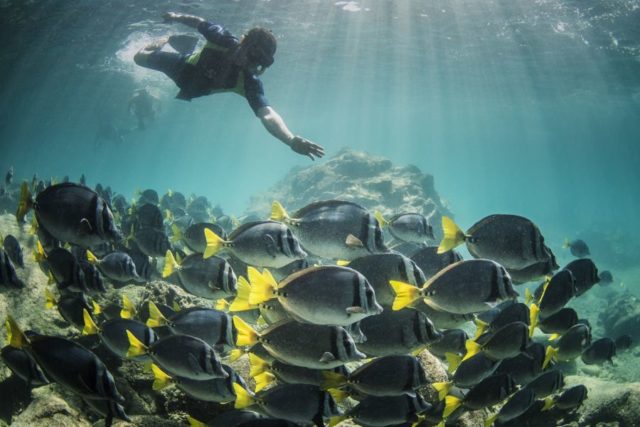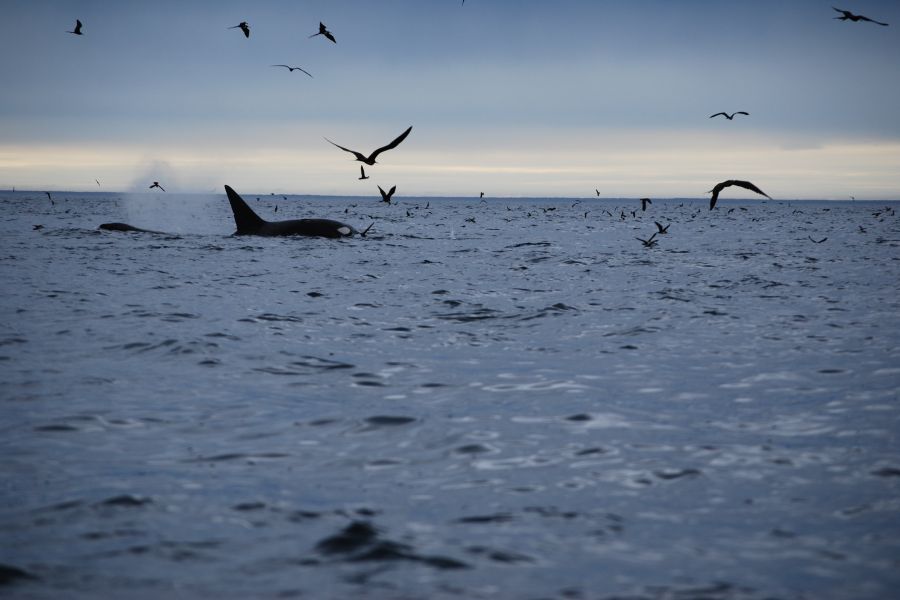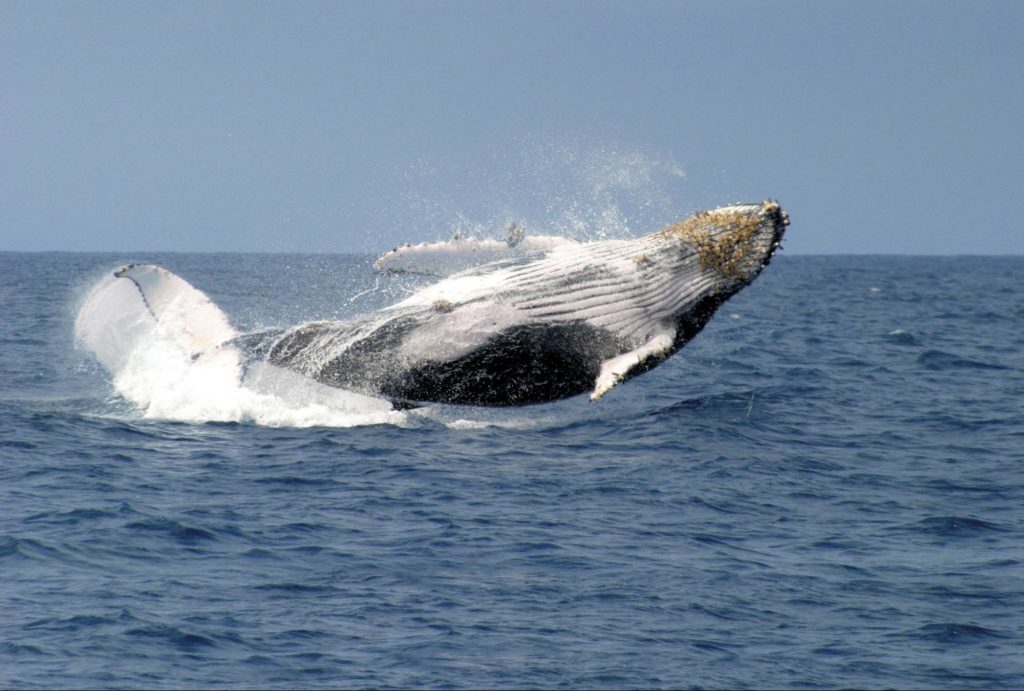
The Galapagos Islands are a year-round paradise. You will find beautiful weather and great options to explore and play no matter when you arrive. Since the Galapagos is such a diverse ecosystem, many guests choose to plan their holiday around the life cycles of the animals that make the Galapagos so special. Here is a quick guide on the big things happening each month in the Galapagos:
Seasonal Highlights in the Galapagos
When to plan your Galapagos trip often depends on the activities you want to do there. The climate is beautiful anytime, but for animal photography, birding, or scuba diving there are certain times of year that are ideal.
Wildlife Photography(Nesting and hatching season): July – September
If you want to catch the nesting and hatching of young sea turtles, boobies, and sea lions the best time to visit is in the dry season from the end of June to mid-September. Consider the West Galapagos itinerary to get the best snorkeling with young lions as they are learning to hunt.
Bird Watching and Photography: December – April
The migration of the waved albatross is one of the greatest animal migrations anywhere in the world, with over 15,000 mating pairs making their way to Esponola to next and raise their young. The South Galapagos is your best bet to see this wonder. Otherwise look to the North Galapagos itinerary to visit Genovesa Island, the best general birding spot in the Galapagos year round
Scuba Diving and Snorkeling:September – November
The water is warmest and calm during these months, giving clear and easy diving conditions. The wildlife are very active, including sea lion pups and Galapagos penguins that are just learning to swim and hunt on their own. Consider the West Galapagos to take advantage of the Cromwell Current off the west coast of Isabela or the South Galapagos to experience snorkeling in the coral reefs of the Devil’s Crown.
Whale Watching: June – October
There are over 20 species of whales and dolphins that live or migrate through the Galapagos, including humpback, sperm whales, orca, and others. Look to the North Galapagos and West Galapagos itineraries for the best whale watching opportunities.
Holiday Season: December – January
This is a very popular time in the Galapagos. The weather is warm and sunny and the wildlife are all very active. If you are planning your trip from late November to mid-January please plan on booking far in advance, as spots can sell quickly on all of our itineraries.
Rainy Season: February – March
The Galapagos does not have a heavy rainy season, but in February and March you are more likely to have rainy days than other times of the year. The weather is warmer and the rains are generally short – it can be a good time to avoid the crowds and visit during the quiet period.
You can find a more detailed summary for each month below, and if you have any questions our Adventure Experts can help (click here to inquire).
The Galapagos Islands are a year-round paradise. You will find beautiful weather and great options to explore and play no matter when you arrive. Since the Galapagos is such a diverse ecosystem, many guests choose to plan their holiday around the life cycles of the animals that make the Galapagos so special. Here is a quick guide on the big things happening each month in the Galapagos:
January:
The male marine iguanas are brightly colored and beautiful as they try to attract mates on the beaches of Espanola Island, sea turtles are laying eggs on beaches throughout the Galapagos, and giant tortoises are hatching at the reserves and Darwin Research Station.
The weather is wet and humid, with light rains being fairly common. The average high temperature is 84 degrees Fahrenheit (29 C), while the low is 70 degrees (21 C). The water temperature is on average 74 degrees Fahrenheit (23 C).
February:
The flamingoes are nesting on Floreana Island, penguins begin their migration from Bartolome to the cooler waters of Isabella and Fernandina Islands, and the Nazca boobies are emerging from their nests to explore and find mates of their own.
Air and water temperatures are warmer as the rainy season is starting. Average high temperatures are 86 degrees Fahrenheit (30 C), while average low temperatures are 75 degrees Fahrenheit (24 C). The water temperature averages 79 degrees Fahrenheit (26 C).

March:
The marine iguanas have finished their mating and begin nesting on Fernandina and North Seymour islands. This is the perfect time for snorkeling and diving with warm, smooth, and clear waters throughout the region.
The weather is warmer and rainier than other times of the year. The average high temperature is 88 degrees Fahrenheit (31 C), with an average low of 75 degrees Fahrenheit (24 C). If you want to avoid the rains look at trips later in the month as the season passes.
April:
April is the nesting season for many of the most special residents of the Galapagos. The waved albatross return to Española and begin their courtship and nesting.
With the recent rains the plant life on the islands is green and lush and the weather is clear and nice. The warm March weather continues, with average high temperatures of 85 degrees Farhenheit (29.5C) and average low temperatures of 73 degrees Farhenheit (23 C).
May:
The blue-footed boobies are out en mass to begin their courting season. Throughout the islands you will find these wonderful birds showing off their famous blue feet and practicing their unique dance to attract a mate.
The sea lions begin their mating season, swimming playfully throughout the shallow waters near the islands as they too search for a mate.
The weather continues to be cool, and the lack of rain causes the arid zones along the shore to dry out, with only the highlands keeping their greenery. Average high temperatures are 82 degrees Fahrenheit (28C), with lows of 72 F (22 C). Water temperatures are around 75 F (24 C)
June:
The famous giant tortoises begin their long, slow migration from the highlands of Santa Cruz to the shoreline to lay their eggs. Humpback whales and whale sharks both migrate into the cooler waters, especially around the northwestern islands. It’s a wonderful time to be on the water.
This is the start of the dry season in the Galapagos, when clear sunny days are a fixture and rains are rare. The weather is just about perfect, with average high temperatures of 79 Fahrenheit (26 C) and lows of 70 F (21 C). The water average temperature is 76 F (24 C).

July:
The blue-footed boobies have gone to nest and the greater flamingos begin their courtship, dancing in the shallow wetlands to find mates of their own. Whale sharks are often visible as they continue their migration past Darwin and Wolf Islands.
July is cooler than June, and a great time for those who enjoy cooler temperatures. The average high is 77 degrees Fahrenheit (25 C), while the average low is only a few degrees cooler at 74 degrees F (23 C). The water temperature is nearly the same as the air in July and there are stronger winds and currents to consider when planning a snorkel or diving trip.
August:
This is the birthing season for sea lions, newborn pups are a common sight along the western and central islands. Hiking through the nesting areas of blue-footed boobies and frigatebirds is especially good as the young are hatching and beginning to wean from their parents.
The temperature doesn’t change much throughout the day in August, with average low and high temperatures of around 66 degrees Fahrenheit (19 C). August frequently has the coolest air and water temperatures the Galapagos experiences all year. However, this is a comfortable climate and even the coolest temperatures rarely require more than a light jacket on the islands.
September:
This is a wonderful time to watch the baby sea lions as they begin to swim and tease the sharks off the shoreline. Humpback whales and whale sharks begin their migration north and provide excellent whale watching. The Galapagos penguins begin their courtship, flocking to Bartolome Island through September to find their mates.
The weather warms in September, with average high temperatures of 75 degrees Fahrenheit (24 C) and low temperatures of 64 F (18 C). Expect some rainy weather, as this is the peak of the light rain season in the Galapagos. The water is usually around 72 degrees Fahrenheit (22 C) this time of year.
October:
This is a great time to catch the blue-footed booby chicks on Española and Isabella islands, providing great observation close to town. With the Humboldt current coming from the Antarctic passing through the water is very nutrient-rich. This provides great chances to watch the fish and birds hunt throughout the islands.
Snorkeling and diving are great this time of year, with very active fish, sea turtles throughout the islands. The sea lion pups are just learning to swim and love to play with snorkelers – but keep an eye out for protective parents!
Average temperatures: High of 77 Fahrenheit (25 C) and low of 71 Fahrenheit (22 C). One of the driest months of the year with clear skies and very little rain.

November:
This is the best time to swim and snorkel with the sea lion pups throughout the Islands. They are just learning to explore off the shore and are very playful. Green sea turtle mating season has begun, and you’ll find the last opportunities of the year to see the whale shark migration on the northwestern islands.
November has some of the most pleasant weather in an already beautiful climate. The average high temperature is 79 degrees Fahrenheit (26 C), with an average low of 70 degrees Fahrenheit (21 C). The sea temperature is warmer than you might expect, with averages around 73 F (23 C).
December:
With the beautiful weather and holiday season, December is one of the busiest times in the Galapagos. It’s the time when the giant tortoises begin to hatch and the land iguanas begin their mating. The bird watching is especially good, so make sure you pack your binoculars and a good lens for your camera.
The average high temperature is 81 degrees Fahrenheit (27 C), with an average low temperature of 74 F (24 C). The water temperature is great, with an average of 73 F (23 C).
Other questions about planning your Galapagos adventure? Let one of our Adventure Experts help! (click here to inquire).

Suggested Reading:

















